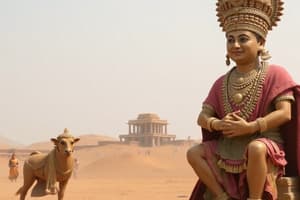Podcast
Questions and Answers
Who was hailed as the most powerful ruler of the Shakas?
Who was hailed as the most powerful ruler of the Shakas?
- Rudradaman (correct)
- Vasudeva
- Kanishka
- Pushyamitra Shunga
Which ruler is associated with the foundation of Purushpur?
Which ruler is associated with the foundation of Purushpur?
- Pushyamitra Shunga
- Vasudeva
- Kujula Kadphises (correct)
- Rudradaman
Who is known as the Einstein of India from Kanishka's kingdom?
Who is known as the Einstein of India from Kanishka's kingdom?
- Vasumitra
- Charaka
- Nagarjuna (correct)
- Ashvaghosha
Which ruler is credited with starting the Saka Samvat in 78 AD?
Which ruler is credited with starting the Saka Samvat in 78 AD?
Who composed the 'Buddhacharita' and was the court poet of Kanishka?
Who composed the 'Buddhacharita' and was the court poet of Kanishka?
Which ruler performed the Ashwamedha Yagya twice in his lifetime?
Which ruler performed the Ashwamedha Yagya twice in his lifetime?
'Mahavibhasha Sutra', considered an encyclopedia of Buddhism, was composed by whom?
'Mahavibhasha Sutra', considered an encyclopedia of Buddhism, was composed by whom?
What was the capital of the Sunga rulers?
What was the capital of the Sunga rulers?
Who is considered as the most glorious ruler of the Kushan dynasty?
Who is considered as the most glorious ruler of the Kushan dynasty?
Which ruler was a follower of Buddhism (Mahayana)?
Which ruler was a follower of Buddhism (Mahayana)?
Flashcards
Gupta Period
Gupta Period
The era during which the Gupta Dynasty ruled India, noted for its flourishing of art, science, literature, and philosophy.
Srigupta
Srigupta
The founder of the Gupta Dynasty, who defeated Satakarni and established his rule.
Sanskrit
Sanskrit
The official language of the Gupta Period, known for its rich literary tradition.
Vaishnavism
Vaishnavism
Signup and view all the flashcards
Dashavatar Temple
Dashavatar Temple
Signup and view all the flashcards
Chandragupta I
Chandragupta I
Signup and view all the flashcards
Samudragupta
Samudragupta
Signup and view all the flashcards
Chandragupta II
Chandragupta II
Signup and view all the flashcards
Pushyabhuti
Pushyabhuti
Signup and view all the flashcards
Harshavardhana
Harshavardhana
Signup and view all the flashcards
Study Notes
Gupta Period (319 AD - 540 AD)
- The Gupta period is known as the 'Golden Age' due to its cultural achievements.
- The dynasty was founded by Srigupta, who defeated Satakarni, the last ruler of the Satvahana dynasty.
- Sanskrit was the official language of the Gupta period.
- The Gupta emperors were followers of Vaishnavism.
- The Dashavatar temple, situated on the Betwa coast, is an important relic of Vaishnavism from the Gupta period.
Chandragupta I (319 AD - 334 AD)
- Chandragupta I married the Licchavi princess Kumaradevi and assumed the title of 'Maharajadhiraja'.
- He started the Gupta Era (319-320 AD).
Samudragupta (335 AD - 380 AD)
- Samudragupta is known as the 'Napoleon of India' due to his military prowess.
- He was a lover of music and inscribed the idol of the goddess playing the veena on his coins.
- Samudragupta was also known as Kaviraj.
- Harisena, his court poet, composed the Allahabad Prasasti, which praised the state system of Samudragupta.
Chandragupta II (380 AD - 414 AD)
- Chandragupta II, also known as 'Vikramaditya', defeated the invasion of Shakas in India.
- He issued silver coins after his victory over the Shakas.
- The Navratna of Chandragupta II's court included Amar Singh, Dhanvantari, Harisena, Kalidasa, Kshapanaka, Shanku, Varahamihira, Araruchi, and Vetalabhatta.
- Scholars like Aryabhatta and Brahmagupta were also part of his court.
- Vishnugupta composed the Panchatantra, and Sudraka wrote the Mrichchhakatikam during this period.
- Nalanda University was established by Kumaragupta.
- Skanda Gupta got artificial lakes constructed.
Pushyabhuti Dynasty
- The founder of the Pushyabhuti Dynasty was Pushyabhuti, but its real founder was Prabhakarvardhan.
- Harshavardhana, who sat on the throne of Thaneshwar at the age of 16 in 606 AD, took over Kannauj and made it his capital.
- Pulakeshin II of the Chalukya dynasty defeated Harsha on the Banks of the Narmada.
- The Chalukya Records mention Harsha as Sakalottarapatheshvara (the lord of the entire north).
- Banabhatta was the court poet of Harsha and composed Harshacharita and Kadambari.
Studying That Suits You
Use AI to generate personalized quizzes and flashcards to suit your learning preferences.




